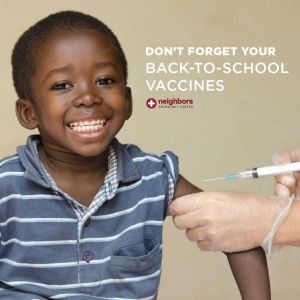
A healthy school year can breed academic success. With August here, it’s time to begin setting up doctors’ appointments to get your children’s vaccines current. From immunizations to sleep to a healthy diet, keep your kids strong this year.
Neighbors Emergency Center is always committed to keeping your child healthy. Check out our simple back to school checklist, designed with your kids’ wellness in mind.
Get Vaccinated
August is National Immunization Awareness Month. Vaccinations are important for people of all ages, especially children. It is important to make their doctors’ appointments so they can get the proper vaccines. Be sure to ask your doctor about these vaccines and keep an updated record at home.
There are several vaccines recommended, specifically for boys and girls 11-12 years old:
Quadrivalent meningococcal conjugate vaccine
This vaccine protects against the bacteria that can cause infections near the lining of the brain, spinal cords and bloodstream. These particular infections can be fatal to your child.
HPV or Human papillomavirus (HPV) vaccine
These vaccines protect your children against HPV infections, which can cause cancer. This vaccine is given in a series of shots and should be completed by a child’s 13th birthday.
Tdap vaccine
This protects children against three very serious diseases: tetanus, diphtheria and pertussis, also known as whooping cough.
Flu vaccine
The flu vaccine should be given to preteens and teens every single year by the end of October. If your teen has a chronic health condition, such as asthma or diabetes, a flu shot is crucial.
Additional Vaccines include:
Polio Vaccine
This vaccine is meant to prevent poliomyelitis, or polio, which is a potentially deadly and infectious disease. It can spread from person to person and affects the body by invading the brain and spinal cord, resulting in paralysis. IVP (inactivated polio vaccine) is usually given at 2 months and 6 years of age.
MMR Vaccine (Measles, Mumps and Rubella)
The MMR vaccine protects against measles, mumps and rubella. These diseases are viral and usually begin with fever, cough and runny nose. If the virus infects the lungs, it can result in pneumonia.
Hepatitis B & Hepatitis A Vaccine
These viruses are different but have similar effects on the body. Hepatitis causes liver inflammation that can be life-threatening. While Hepatitis B is for newborns, Hepatitis A is for children ages 12-23 months.
Stock up on Healthy Food
Make sure you steer clear of junk foods that can make children feel sluggish. Stock healthy foods such as fruits, vegetables, whole-grain breads and lean protein. Make your mornings easier by meal prepping so your kids’ lunches will be ready throughout the week. Hard-boiled eggs, tuna salad and fruit cups are perfect for storing in containers.
Recommended Nutrients and Snacks:
Calcium
It’s time to add more milk. Most kids ages 4 to 8 are not getting enough calcium. Calcium is important for bone development and growth, which is crucial during adolescence and childhood. Calcium rich foods include cheese, yogurt and milk.
Vitamin E
Almost 80 percent of kids under 8 are missing their daily dose of Vitamin E. Remember, going fat-free is not always the best option as it can sometimes cut out the healthy fats our bodies need. Vitamin E is in avocado, nuts, peanut butter, sunflower seeds, spinach and tomato sauce.
Fiber
Fiber keeps your child’s movements regular while helping them feel full. How much fiber your child needs is dependent on their age, so talk with your doctor about how many grams is best for their diet. Fiber is in fruits, cereal, beans, whole-grain bread, popcorn, oatmeal and sweet potatoes.
Potassium
60 percent of children get too little potassium. This is usually due to a lack of fruits and veggies in their diets. Your kids can get a dose of potassium from bananas, oranges, potatoes, yogurt, milk, cantaloupe, honeydew, tomatoes and fish like halibut and cod.
Iron
Iron plays a key role in brain development as it helps blood cells carry oxygen throughout the body. Lack of iron can lead to learning and behavioral problems. The best iron sources are shrimp, beef, chicken, beans, raisins, whole wheat bread and lentils.
Set Bedtimes
During the summertime, children’s sleep schedules go from a strict bedtime and wake up call, to late nights and sleeping in. Transitioning back to a school schedule can be difficult, so start practicing this sleep schedule a few weeks in advance. Research has shown that a bedtime between 7 P.M. and 8 P.M. works best for school-aged kids.
Recommended Sleep Hours:
• 10-13 hours for preschoolers (ages 3-5)
• 9-11 hours for school aged children (ages 6-13)
• 8-10 hours for teenagers (ages 14-17)
In addition, be sure your child goes off to school with a good breakfast and lunch. Having a nutritional meal can help your child focus throughout the day.
As you prepare for the school year, know you can turn to Neighbors for emergency medical care. If you find yourself in need of emergency services, remember we have several Neighbors Emergency Center locations throughout Texas. Our board-certified physicians and state-of-the-art technology make it easy for us to care for your family’s medical emergencies.

